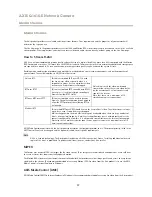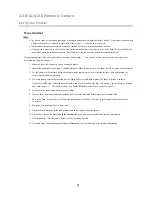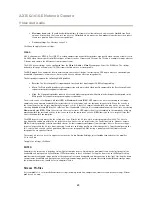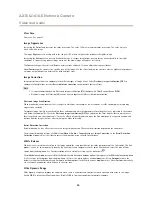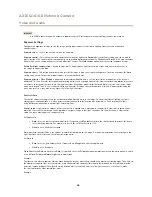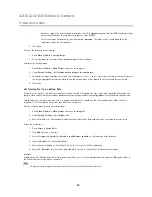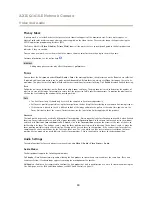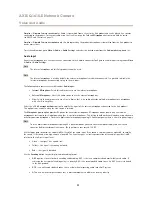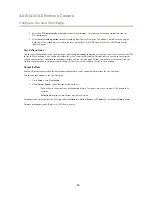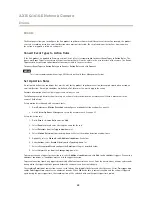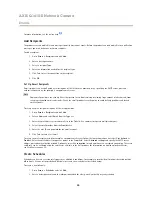
AXIS Q1615-E Network Camera
Video and Audio
Simplex — Network Camera speaker only -
Audio is transmitted from a client to the Axis product and can be played by a speaker
connected to the product. To transmit audio using the Live View page, the
Talk
and
Microphone
buttons must both be active,
see
AMC Audio Controls on page 15
.
Simplex — Network Camera microphone only -
Audio captured by the product microphone is transmitted from the Axis product to
one or more clients.
To set the audio mode, go to
Video & Audio > Audio Settings
and select the desired mode from the
Audio mode
drop-down list.
Audio Input
An external microphone or a line source can be connected to the Audio-in connector. Configure the audio input settings under
Video
& Audio
>
Audio Settings
.
Note
The internal microphone on this Axis product cannot be used.
Note
The internal microphone is used by default; the external microphone is used when connected. It is possible to disable the
internal microphone by connecting a plug to the mic input.
The following audio sources are available under
Audio Input
:
•
Internal Microphone:
Select this audio source to use the internal microphone.
•
External Microphone:
Select this audio source to use the external microphone.
•
Line:
Select this audio source to use a Line in device, that is, an audio mixer for multiple microphones or a microphone
with a built-in amplifier.
Select the
+30 dB microphone boost
option to amplify the signal of the external microphone connected to the Axis product.
This option is not available when the Line source is selected.
The
Microphone power
option provides DC power for an external microphone. Microphone power should only be used with
microphones that require this kind of powering, that is, electret microphones. This setting should not be enabled when using a dynamic
or battery powered microphone. For use of a professional microphone requiring 12 V phantom power, there is a built-in power supply.
Note
To use a professional microphone requiring 48 V phantom power, you need an external power supply and a balanced
converter (audio transformer) in between. The input must never exceed 12 V DC.
Use the
Input gain
to control the volume (dB Full Scale) of the audio input. If the sound is too low, choose a higher dB, to amplify
the sound. If the sound is too high, choose a lower dB. The
Level
bar gives a visual representation of the audio signal level in dB
relative to the full-scale input level.
•
Green — the signal is at a good level.
•
Yellow — the signal is becoming distorted.
•
Red — the signal is distorted.
Use the
Encoding
option to select digital audio encoding format.
•
AAC
requires a license for both encoding and decoding. AAC is the least complicated and most widely used codec. If
achieving the best possible audio quality is a priority, AAC is the recommended codec to use. An AAC license is included
in the Axis product.
•
G711
is an unlicensed standard codec that is useful when integrating audio into a VoIP system
•
G726
is an unlicensed speech codec that is most commonly used within the security industry.
31

